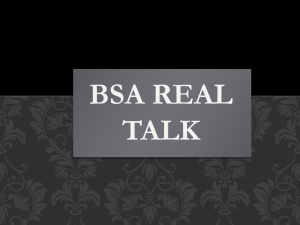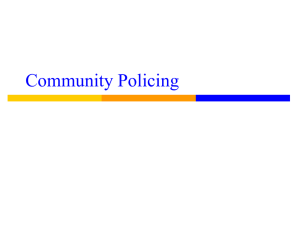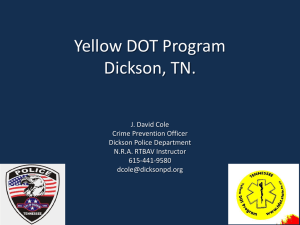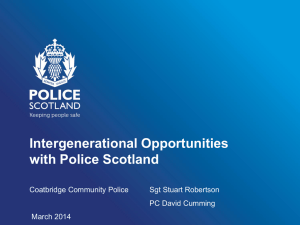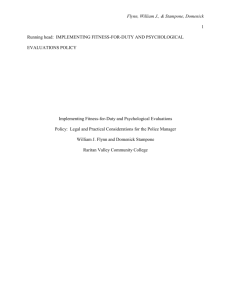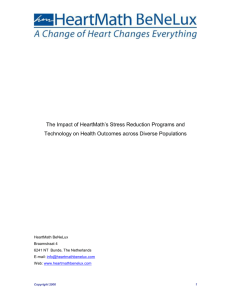The Stress of Command
advertisement
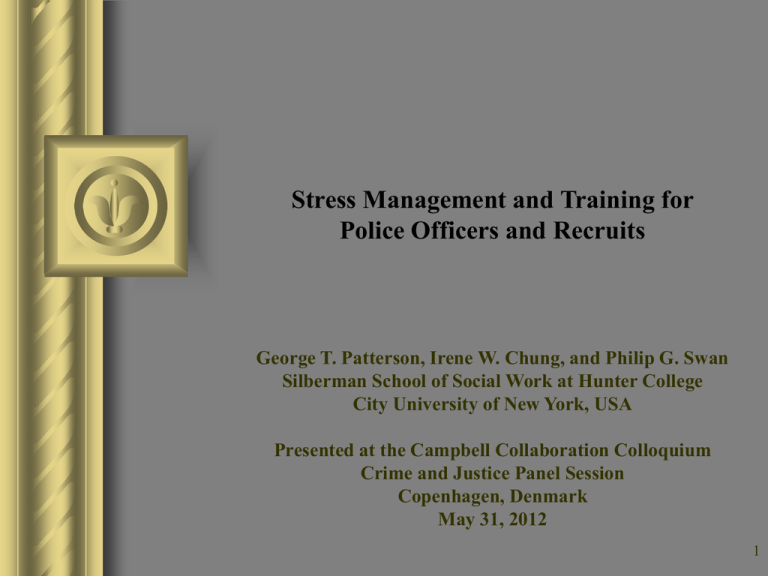
Stress Management and Training for Police Officers and Recruits George T. Patterson, Irene W. Chung, and Philip G. Swan Silberman School of Social Work at Hunter College City University of New York, USA Presented at the Campbell Collaboration Colloquium Crime and Justice Panel Session Copenhagen, Denmark May 31, 2012 1 Background Occupational and life stress can have negative physiological, psychological and biological affects on police officers job performance and social functioning Because police officers are first responders to many types of situations stress can also adversely affect those they help Law enforcement organizations provide many types of interventions to help both veteran and recruit police officers manage stress. The most common intervention is general training to recognize signs of stress and ways of coping (On the Job, 2000; Sewell, 1999) 2 Objectives Identify, retrieve, evaluate and synthesize available studies assessing stress management training program outcomes for police officers and recruits Review Question: What are the effects of officer stress management and development programs on stress outcomes? 3 Search Strategy Electronic databases Handsearched relevant journals, books, and conference proceedings Internet websites Visually scanned reference lists from relevant studies Searched for “grey literature” Contacted organizations and authors police and ((stress or suicide or "substance abuse" or "alcohol abuse") and (management or prevention or awareness or debriefing or development)) and (training or program*) 4 Selection Criteria Veteran police officers and/or recruits Any psychosocial or physical intervention Randomized controlled trial (RCT) or comparison group Quantitative methods Published and non-published studies (doctoral dissertations/master’s theses, conference papers, book chapters) Any geographic location 5 Data Collection and Analysis Meta-analysis was performed using Comprehensive MetaAnalysis Version 2.2.050 (Borenstein et al. 2009) Multiple outcomes and time points were not treated as independent Effect sizes were separated by outcome type (psychological, behavioral and physiological) and analyzed separately for different outcomes types Multiple outcomes were averaged Effect sizes were not averaged across different outcome types Effect sizes were calculated using reported means, standard deviations and sample sizes, and reported Cohen’s d and t-test study results 6 Additional Analyses Sensitivity analysis Moderator analyses Heterogeneity test 7 Results 678 titles/abstracts identified and screed, 25 retrieved studies, 13 excluded studies Sample size = 906 (401 males, 91 female) Average age = 34.48 (SD = 3.57) years Average years of police experience = 10.77 (SD = 4.00) years Methods random assignment n = 9 quasi-experimental designs n = 3 8 Results Table 1 - Hedge’s g Random Effects for Behavioral Outcomes Study name Outcome T ime point Statistics for each study Hedges's Standard Lower g error Variance limit McCraty et al CombinedCombined Hedges's g and 95% CI Upper limit Z-Value p-Value 0.041 0.258 0.067 -0.465 0.546 0.158 0.875 Norvell et al CombinedCombined 0.194 0.368 0.135 -0.526 Shipley et al CombinedPosttest -0.695 0.277 0.077 0.915 0.528 0.597 -1.238 -0.153 -2.512 0.012 -0.176 0.277 0.077 -0.719 -0.635 0.525 0.367 -2.00 -1.00 Fav ours A 0.00 1.00 2.00 Fav ours B 9 Results Table 2 - Hedge’s g Random Effects for Physiological Outcomes Study name Outcome T ime point Statistics for each study Hedges's Standard Lower g error Variance limit Hedges's g and 95% CI Upper limit Z-Value p-Value McCraty et al CombinedCombined 0.324 0.260 0.068 -0.185 0.833 1.247 0.213 Short et al 0.030 0.295 0.087 -0.549 0.609 0.102 0.919 0.196 0.195 0.038 -0.187 0.578 1.003 0.316 CombinedCombined -2.00 -1.00 Fav ours A 0.00 1.00 2.00 Fav ours B 10 Results Table 3 - Hedge’s g Random Effects for Psychological Outcomes Study name Outcome T ime point Statistics for each study Hedges's Standard Lower g error Variance limit Short et al Combined T anigoshi et alCombined Ackerley Combined Coulson Combined Digliani Combined Gersons et al Combined Ireland et al Combined McCraty et al Combined Norvell et al Combined Richmond et alP sy stress Wilson et al Combined Shipley et al Psy anxiety Combined Combined Combined Combined Combined Combined Combined Combined Combined Combined Posttest Posttest -0.022 0.095 -0.110 -0.341 -0.170 -0.485 0.018 0.054 -0.317 0.028 0.975 0.462 0.038 0.295 0.278 0.282 0.305 0.279 0.312 0.176 0.259 0.370 0.107 0.268 0.272 0.098 0.087 0.077 0.080 0.093 0.078 0.097 0.031 0.067 0.137 0.011 0.072 0.074 0.010 -0.599 -0.450 -0.663 -0.939 -0.717 -1.097 -0.327 -0.453 -1.043 -0.182 0.449 -0.072 -0.155 Hedges's g and 95% CI Upper limit Z-Value p-Value 0.556 0.640 0.443 0.257 0.377 0.126 0.363 0.561 0.409 0.238 1.500 0.995 0.230 -0.073 0.342 -0.390 -1.117 -0.608 -1.556 0.102 0.209 -0.855 0.258 3.636 1.697 0.384 0.942 0.732 0.696 0.264 0.543 0.120 0.919 0.834 0.392 0.796 0.000 0.090 0.701 -2.00 -1.00 Fav ours A 0.00 1.00 2.00 Fav ours B 11 Results Additional analyses Sensitivity analysis - Each analysis resulted in a zero effect Moderator analyses - Similarly, each analysis resulted in a zero effect Heterogeneity test results Psychological outcomes: K = 12 Q = 20.844 df = 11 p = 0.035 Physiological outcomes: K = 2 Q = 0.558 df = 1 p = 0.455 Behavioral outcomes: Q = 5.22 df = 2 K=3 p = 0.074 Hedge’s g = 0.038 I2 = 47.23 Hedge’s g = 0.196 I2 = 0.00 Hedge’s g = -0.176 I2 = 61.689 12 Funnel Plot of Precision by Hedge’s g Funnel Plot of Precision by Hedges's g 10 Precision (1/Std Err) 8 6 4 2 0 -2.0 -1.5 -1.0 -0.5 0.0 0.5 1.0 1.5 2.0 Hedges's g 13 Conclusions Many studies had missing data (rank, some outcomes not reported) Penalba, McGuire and Leite (2009) noted missing data and low quality studies. They concluded insufficient evidence exists to conclude whether the interventions were effective We also found a wide variation in the types of interventions, outcomes, and measurement instruments used 14 Types of Interventions 1. Brief interventions 2. Brief eclectic psychotherapy 3. Circuit weight training 4. Eye Movement Desensitization and Reprocessing (EMDR) Program 5. HeartMath stress and emotional self-management techniques 6. Individual wellness counseling 7. Nutrition and physical conditioning program 8. Stress inoculation training 9. Stress management program 10. Stress reduction program 11. Visuo-motor behavior rehearsal 12. Writing intervention 15 Outcomes Psychological outcomes: 12 studies Physiological outcomes: 2 studies Behavioral outcomes: 3 studies 16 Implications for Policy and Practice 1. First, determine focus of intervention (life, work, or traumatic stress) 2. Second, intervention should be tailored to law enforcement 3. Third, test the intervention in a wide variety of law enforcement settings emphasizing replication using RCT, and consistent outcomes and measures Requires a buy-in from law enforcement organizations and personnel 17 Studies included in the meta-analysis Ackerley, D.G. (1986). The effects of a stress management program on police personnel. Dissertation Abstracts International, DAI, 48, no. 05A. Coulson, J.E. (1987). The effectives of a stress reduction program for police officers. Dissertation Abstracts International Digliani, J.A. (1994). Stress inoculation training: The police. Dissertation Abstracts International DAI, 56, no. 04B Gersons, B.P.R., Carlier, I.V.E., Lamberts, R.D., & van der Kolk, B.A. (2000). Randomized clinical trial of brief eclectic psychotherapy for police officers with posttraumatic stress disorder. International Society for Traumatic Stress Studies, 13(2), 333-347. doi: 10.1023/A:1007793803627 Ireland, M, Malouff, J.M., & Byrne, B. (2007). The efficacy of written emotional expression in the reduction of psychological distress in police officers. International Journal of Police Science & Management, 9(4), 303-311. doi: 10.1350/ijps.2007.9.4.303 McCraty, R., & Tomasino, D. (1999). Impact of the HeartMath self-management skills program physiological and psychological stress in police officers. Boulder Creek, CA: HeartMath Research Center, Publication No. 99-075. Norvell, N., & Belles, D. (1993). Psychological and physical benefits of circuit weight training in law enforcement personnel. Journal of Consulting and Clinical Psychology, 61(3), 520-527. doi: 10.1037/0022-006X.61.3.520 Richmond, R.L., Kehoe, L., Hailstone, S., Wodak, A., & Uebel-Yan, M. (1999). Quantitative and qualitative evaluations of brief interventions to change excessive during, smoking and stress in the police force. Addiction, 94(10), 1509-1521. Shipley, P., & Baranski, J. V. (2002). Police officer performance under stress: A pilot study on the effects of visuo-motor behavior rehearsal. International Journal of Stress Management, 9(2), 71-80. doi: 10.1023/A:1014950602826 Short, M. A., DiCarlo, S., Steffee, W. P., & Pavlou, K. (1984). Effects of physical conditioning on self-concept of adult obese males. Physical Therapy, 62(2), 194-198. Tanigoshi, H., Kontos, A. P., & Remley, T. P. (2008). The effectiveness of individual wellness counseling on the wellness of law enforcement officers. Journal of Counseling & Development, 86, 64-74. Wilson, S. A., Tinker, R. H., Becker, L. A., & Logan, C. R. (2001). Stress management with law enforcement personnel: A controlled outcome study of EMDR versus a traditional stress management program. International Journal of Stress Management, 8(3), 179-200. doi: 10.1023/A:1011366408693 18 Acknowledgements We thank the following individuals and organizations: National Policing Improvement Agency, Campbell Collaboration Crime and Justice Group, and George Mason University for funding this systematic review Dr. David B. Wilson for his generous time, support and knowledge assisting the review team with conducting this systematic review Daniel Schmidt who managed the study selection process and references Professor Marvie Brooks, Instruction Librarian, John Jay College of Criminal Justice (CUNY) New York, NY for assisting with the search strategy 19




